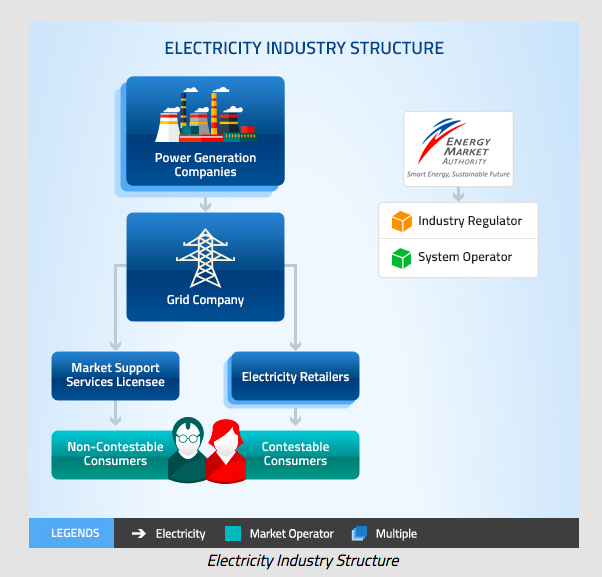- Published on
A short summary of Singapore’s electricity market
- Authors
-
-

- Name
- Vivienne Roberts
- in/viviroberts
-
There are a number of players in Singapore’s electricity market and the best summary that I’ve found to date is on the Energy Market Authority’s website found here. This short document gives a high level overview of who the main parties are, how they interact, how the electricity and funds flow between them, and who qualifies for what. It’s a good read, but I thought it would be useful to distill some of the key facts, and add a few other items that I’ve learned as I’ve investigated this a bit.

Contestable vs non-contestable consumers:
There are two types of electricity consumers: contestable and non-contestable.
Non-contestable consumers do not have any choice as to where they purchase their electricity from. They are customers of the National Electricity Market of Singapore (NEMS), which is operated by a licensed entity – SP Services.
Contestable consumers, on the other hand, can choose to purchase electricity from licensed retailers, or from the NEMS, depending on which suits their consumption patterns best. In order to qualify to be a contestable consumer, the monthly consumption of the consumer needs to be more than 2,000kWh, with a bill of at least S$550. Consumers in different locations can aggregate their consumption to qualify as a group to be a contestable consumer.
There appears to be increasing interest amongst consumers to be considered as contestable, as the threshold to qualify was halved for both monthly consumption and monthly spend in July 2015.
Licensed entities:
The Energy Market Authority is the industry regulator for electricity, gas and district cooling and the system operator. They issue licences and regulate Singapore’s competitive electricity market. The following are licensed entities present in Singapore’s electricity market:
- Generators – there appear to be 14 generators licensed. Generators have capacity of one or more unit generating 10MW each.
- Retailers – there also appear to be 14 retailers licensed. They are not necessarily the same entity as the generators. These retailers are authorised to sell electricity to contestable companies. If they are market participant retailers, they need to be registered with the Energy Market Company, to purchase electricity from the NEMS, and to sell onwards to contestable consumers. If they are not registered, they can purchase electricity from the Market Support Services Licensee (currently SP Services) and resell on.
- Wholesale Generators – 14 seems to be a bit of a magic number, as there are 14 licences listed on the EMA site. Again, not necessarily the same parties. This licence is required for generators with one or more units between 1MW and 10MW which are connected to the grid. If the generation capacity is less than 1MW they need to be registered with the EMA (i.e. not licensed). If they have more than 10MW, they need to bid into the NEMS to secure dispatch.
- Wholesale Interruptible Load Generator– this licence is required for generators who wish to make their load, or their customers loads, interruptible during periods of a shortage of supply. Here there are less than 14 licensed entities
- Market Supply Services Licensee – this is SP Services. Their role is to manage the
- Settlement of bills
- Meter reading
- Data management
- Transfer services for customers wishing to swap retailers
- For contestable customers with no appointed retailer, facilitation of access to the NEMS
- Supply to non-contestable customers
- Billing and payment for charges relating to the transmission system
- Transmission company – this is SP PowerAssets. They own and manage the national electricity transmission system, and are responsible for all operations and maintenance works required.
- Market Company – this is the Energy Market Company. They operate and administer the wholesale electricity market (NEMS). They schedule generating units, which is interpreted to mean ensuring adequacy of supply for anticipated demand, and they settle the accounts of the market participants.
- Embedded generators – this is for an entity wishing to generate electricity primarily for their own use. They are allowed to connect to the grid, and can sell excess electricity. There does not appear to be a licence required, however, generators are required to apply to the EMA in order to be classified as an embedded generator. The generator will be required to ensure that their load is at least half of the production in any twelve month period. In addition, the majority of the generator facilities, land etc (>50%) is to be owned by the same entity.
Here’s a little graphic from the EMA site showing the overall structure.


